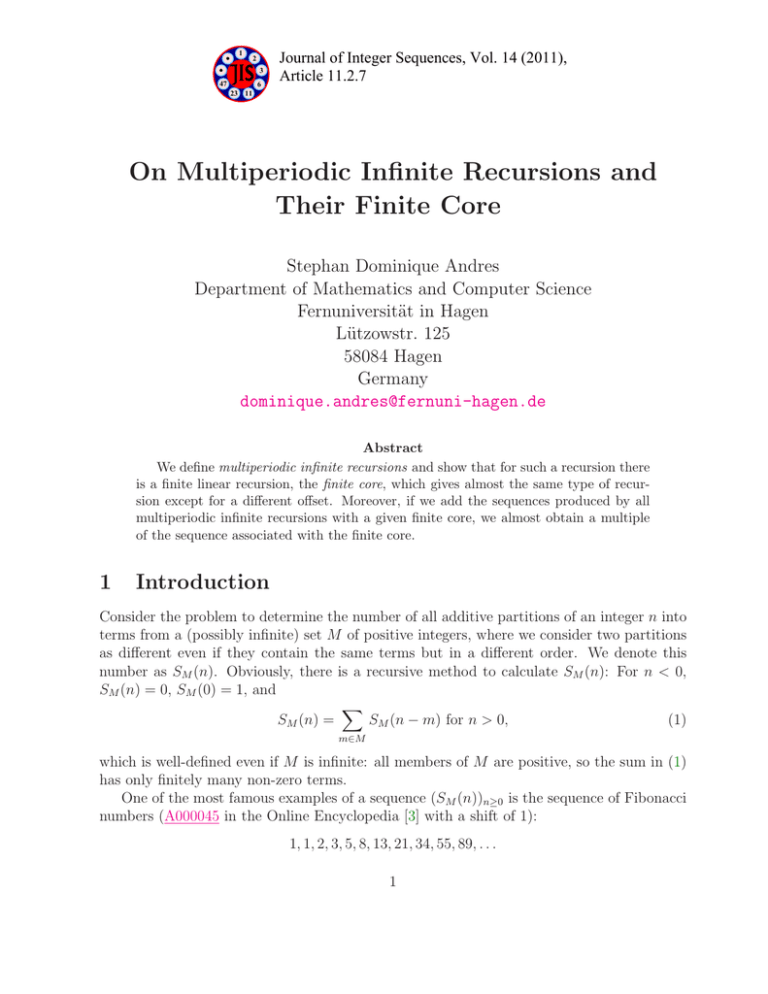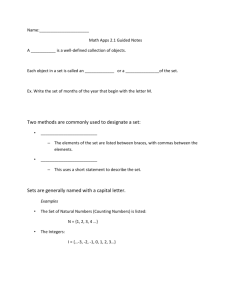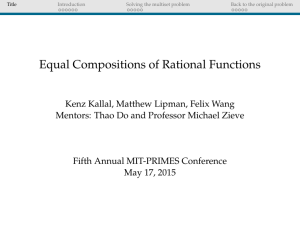On Multiperiodic Infinite Recursions and Their Finite Core
advertisement

1
2
3
47
6
Journal of Integer Sequences, Vol. 14 (2011),
Article 11.2.7
23 11
On Multiperiodic Infinite Recursions and
Their Finite Core
Stephan Dominique Andres
Department of Mathematics and Computer Science
Fernuniversität in Hagen
Lützowstr. 125
58084 Hagen
Germany
dominique.andres@fernuni-hagen.de
Abstract
We define multiperiodic infinite recursions and show that for such a recursion there
is a finite linear recursion, the finite core, which gives almost the same type of recursion except for a different offset. Moreover, if we add the sequences produced by all
multiperiodic infinite recursions with a given finite core, we almost obtain a multiple
of the sequence associated with the finite core.
1
Introduction
Consider the problem to determine the number of all additive partitions of an integer n into
terms from a (possibly infinite) set M of positive integers, where we consider two partitions
as different even if they contain the same terms but in a different order. We denote this
number as SM (n). Obviously, there is a recursive method to calculate SM (n): For n < 0,
SM (n) = 0, SM (0) = 1, and
X
SM (n) =
SM (n − m) for n > 0,
(1)
m∈M
which is well-defined even if M is infinite: all members of M are positive, so the sum in (1)
has only finitely many non-zero terms.
One of the most famous examples of a sequence (SM (n))n≥0 is the sequence of Fibonacci
numbers (A000045 in the Online Encyclopedia [3] with a shift of 1):
1, 1, 2, 3, 5, 8, 13, 21, 34, 55, 89, . . .
1
Here, the underlying set is M = {1, 2}.
We can obtain almost the same sequence from an infinite underlying set, namely the set
M2 = {1, 3, 5, 7, 9, 11, . . .}
of odd positive integers. As sequence (SM2 (n))n≥0 we obtain
1, 1, 1, 2, 3, 5, 8, 13, 21, 34, 55, . . . ,
which looks (except for the beginning) quite like the Fibonacci numbers. Similarly, for the
set
M1 = {2, 3, 4, 5, 6, 7, . . .}
of all positive integers ≥ 2 the sequence (SM1 (n))n≥0 is
1, 0, 1, 1, 2, 3, 5, 8, 13, 21, 34, . . .
– again Fibonacci! However there is still another observation: If we add the last two sequences, we obtain the original Fibonacci sequence, except for the first item of the sequences.
So we observe for all n ∈ Z
SM1 (n) + SM2 (n) = SM (n) + S∅ (n).
(2)
Here the sequence (S∅ (n))n≥0 = (1, 0, 0, 0, . . .) is just the characteristic function of the value
0. Of course this observation is not surprising because of the recursion for the Fibonacci
numbers, nontheless we will see that similar observations hold for very different and more
complicated recursive sequences, even if they are not self-similar sequences as the three
examples above.
Let us analyze how the sets M , M1 and M2 are related. The numbers 1 and 2 of the set
M are the key for this analysis. The set M1 is 1-periodic, starting from the value 2. The set
M2 is 2-periodic, starting from the value 1. So Mi is built from M by deleting the entry i
and introducing a period i instead, which applies for the remaining number and creates an
infinite periodic set. A proof of generalizations of the relation (2) will be the main topic of
this paper.
In order to be able to formulate these generalizations we have to introduce some basic
notation about multisets. For us, a multiset M is a pair (M, w), consisting of a support set
M ⊆ N≥1 and a multiplicity function w : N≥1 −→ N0 with
M = {m ∈ N | w(m) > 0}.
We may also write
M = [m1 , m2 , m3 , m4 , . . .]
as a (possibly infinite) list of positive (possibly not distinct) integers such that every integer
j with j = mi occurs only finitely often in the list, namely exactly w(j) times. The multiset
M is finite if M is finite, otherwise infinite. We will in particular denote finite multisets
by lists of the form [m1 , . . . , mN ]. We denote the empty multiset (∅, w) simply by ∅. Let
M1 = (M1 , w1 ), M2 = (M2 , w2 ) be multisets. We say M2 ⊆ M1 if, for all n ∈ N≥1 ,
2
w1 (n) − w2 (n) ≥ 0, and we write M2 $ M1 if M2 ⊆ M1 and M2 6= M1 . If M2 ⊆ M1 , the
multiset M1 − M2 is defined as (M1′ , w1 − w2 ), where
M1′ = {m ∈ M1 | w1 (m) − w2 (m) > 0}.
Let I be a set and, for all i ∈ I, Mi = (Mi , wi ) be a multiset. Then the sum
!
M
[
X
Mi =
Mi ,
wi
i∈I
i∈I
i∈I
P
is defined in case i∈I wi (n) < ∞ for all n ∈ N. We further define for a multiset M = (M, w)
and a function f : Z −→ Z
X
X
f (m) :=
w(m)f (m).
m∈M
m∈M
Linear recursions have been a classical topic in elementary and analytic combinatorics,
for an overview see Flajolet and Sedgewick [1]. Thinking of recursions, the above model can
be easily generalized from sets M to multisets M. Multisets fit to the partition model in
the following sense. Think of the elements of a multiset M being colored in distinct colors.
Then we want to count the number SM (n) of additive partitions of a number n into parts
from M, respecting the order of the associated colors. If M is a set, this coincides with
our definition above. Again, for n > 0, we have SM (−n) = 0, SM (0) = 1 and the recursive
formula
X
SM (n) =
SM (n − m).
(3)
m∈M
From this linear recursion we obtain the ordinary generating function FM (z) of the sequence
(SM (n))n≥0 , namely
X
X
X
FM (z) = FSM (z) =
SM (n − m)z n−m
SM (n)z n = 1 +
zm
n≥0
=
1−
1
X
zm
m∈M
n≥0
(4)
,
m∈M
which will have non-zero radius of convergence in the cases we will consider.
A multiset M′ is periodic if there are finitely many positive numbers m2 , . . . , mN and a
positive number m1 (the period ), so that M′ is the sum of all multisets of the form
[mi , mi + m1 , mi + 2m1 , mi + 3m1 , . . .],
where i = 2, . . . , N . We call the finite multiset [m1 , m2 , . . . , mN ] the finite core of M′ and
denote M′ by M[m1 ] . For periodic multisets we have the following results:
Theorem 1. Let N ≥ 2 and M = [m1 , m2 , . . . , mN ] be a finite multiset. Then, for any
n ∈ Z,
N
X
SM[m1 ] (n) =
SM[m1 ] (n − mi ) − S∅ (n − m1 ) + S∅ (n).
i=1
3
Theorem 2. Let N ≥ 2 and M = [m1 , m2 , . . . , mN ] be a finite multiset. Then, for any
n ∈ Z,
N
X
SM[mi ] (n) = (N − 1)SM (n) + S∅ (n).
i=1
Theorem 1 states that infinite periodic recursions, i.e., recursions coming from periodic
multisets, can be written as the same finite recursion as their finite core, except for different initial values. Therefore they can be solved by the well-known analysis of finite linear
recursions (see, e.g., Matoušek and Nešetřil [2]). We, however, will not focus on the asymptotic analysis but on a different point, namely Theorem 2, which gives us an exact additive
relation between all periodic multisets with the same finite core and this core. We have
already observed this phenomenon for the Fibonacci numbers. We observe it as well for any
finite multiset, e.g., for the set M = {2, 3, 6}, where (SM (n))n≥0 is the sequence A121833 in
Sloane’s Encyclopedia [3].
Instead of proving Theorems 1 and 2 directly, which could be done either elementary or
analytic, we will formulate a more general setting and prove generalizations of the statements
above. Let M be a finite multiset, and P = [p1 , . . . , pK ] $ M. Then the infinite multiperiodic
multiset MP is defined as the union of all (one-element) multisets of the form
[m + k1 p1 + k2 p2 + . . . + kK pK ]
P
ki
, for all integers k1 , . . . , kK ≥ 0 and all m ∈ M−P.
which are taken with multiplicity k1 ,...,k
K
This is well-defined, since, for any n ∈ N, there are only finitely many (K + 1)-tuples
(m, k1 , . . . , kK ) ∈ NK+1 with
m + k1 p1 + k2 p2 + . . . + kK pK = n.
(Recall that the multiplicities in our multisets are always finite, and m, pi > 0.) Again, we
call M the finite core of MP . The recursion for MP is
P
K
∞
∞ X
X X
X
ki
SMP (n − m −
ki pi ) + S∅ (n)
SMP (n) =
···
k
1 , k2 , . . . , kK
i=1
m∈M−P k =0
k =0
1
K
for all n ∈ Z.
In Section 2 we will formulate and prove the generalizations of Theorems 1 and 2 concerning multiperiodicity. In the Section 3 we discuss a further generalization.
2
Main results
The following theorem generalizes Theorem 1.
Theorem 3. Let N > K ≥ 1 and M = [m1 , m2 , . . . , mN ] be a finite multiset.
Let P = [m1 , m2 , . . . , mK ] and M∗ = M − P. Then, for any n ∈ Z,
SMP (n) =
N
X
SMP (n − mi ) −
K
X
s=1
i=1
4
S∅ (n − ms ) + S∅ (n).
Proof.
FMP (z) =
1−
∞
X
X
∞
X
···
m∈M∗ k1 =0 k2 =0
=
1−
X
z
m
m∈M∗
∞
X
∞
X
ν=0 k1 ,...,kK ≥0
PK
j=1 kj =ν
kj
z m+k1 m1 +k2 m2 +...+kK mK
k1 , . . . , kK
j=1
kK =0
X
1
PK
1
ν
(z m1 )k1 · · · (z mK )kK
k1 , . . . , kK
1
=
1−
X
zm
X
zm
m∈M∗
=
1−
1−
1−
N
X
1
1
1−
z m1
−
z m2
− · · · − z mK
z ms
s=1
=
(z m1 + z m2 + · · · + z mK )ν
ν=0
m∈M∗
K
X
∞
X
.
z mi
i=1
In the first equation we used (4), in the third equation the multinomial theorem, in the fourth
the geometric series. The last expression is the generating function FM as in (4) except for
the different offset as in the statement of the theorem.
We conclude that the sequence function of a multiperiodic multiset is dominated by the
sequence function of its finite core:
Corollary 4. Let N > K ≥ 1, M = [m1 , m2 , . . . , mN ] be a finite multiset and P =
[m1 , . . . , mK ]. Then, for any n ∈ Z,
SMP (n) ≤ SM (n).
Proof. This is because of −
PK
s=1
S∅ (n − ms ) ≤ 0 in the statement of Theorem 3.
The next corollary could be used for an elementary proof of the main Theorem 6, whereas
our analytic proof uses Theorem 3 directly.
Corollary 5. Let N > K ≥ 1 and M = [m1 , m2 , . . . , mN ] be a finite multiset. Then, for
any n ∈ Z,
SM (n) + (K − 1)SM[m1 ,...,mK ] (n) −
K
X
SM[m1 ,...,mK+1 ]−[mj ] (n) = KSM (n − mK+1 ).
j=1
5
Proof. We prove the corollary by induction on n. For n ≤ 0 both sides are zero. Let n > 0
and assume it has been proved for n − 1. Then
by (3)
=
=
SM (n) − KSM (n − mK+1 )
N
X
[SM (n − mi ) − KSM (n − mK+1 − mi )] − KS∅ (n − mK+1 )
i=1
" K
N
X
X
=
SM[m1 ,...,mK+1 ]−[mj ] (n − mi ) − (K − 1)SM[m1 ,...,mK ] (n − mi )
j=1
i=1
#
−KS∅ (n − mK+1 )
K
X
SM[m1 ,...,mK+1 ]−[mj ] (n) − (K − 1)SM[m1 ,...,mK ] (n)
j=1
+
"K+1
K
X
X
j=1
#
S∅ (n − ms ) − S∅ (n − mj )
s=1
−(K − 1)
K
X
S∅ (n − ms ) − KS∅ (n − mK+1 )
s=1
=
K
X
SM[m1 ,...,mK+1 ]−[mj ] (n) − (K − 1)SM[m1 ,...,mK ] (n).
j=1
The second step is by induction hypothesis, and the third step by Theorem 3.
Now we formulate our main result, which generalizes Theorem 2:
Theorem 6. Let N > K ≥ 1 and M = [m1 , m2 , . . . , mN ] be a finite multiset. Then, for
any n ∈ Z,
X
N −1
N −1
SM (n) +
S∅ (n) =
SM[mi ,...,mi ] (n).
1
K
K
K −1
{i1 ,...,iK }⊆{1,...,N }
6
Proof. By Theorem 3 we have
1−
X
{i1 ,...,iK }⊆{1,...,N }
FM[mi
,...,mi ]
1
K
X
(z) =
{i1 ,...,iK }⊆{1,...,N }
1−
K
X
s=1
N
X
z mis
z mj
j=1
=
X
N
N K
N
·1−
z mj
K N j=1
K
1−
N
X
z mj
j=1
N −1
N −1
K
=
+
.
N
K −1
X
1−
z mj
j=1
In the last step we use
N −1
N K
=
,
K −1
K N
N
N −1
N −1
resp.
=
+
.
K
K
K −1
We obtain the required linear combination of the generating functions of the sequences
(SM (n))n≥0 and (S∅ (n))n≥0 .
Corollary 7. Let N ≥ 2 and M = [m1 , . . . , mN ] be a finite multiset. Then, for any n ∈ Z,
X
SMP (n) = 2N −1 − 1 (SM (n) + S∅ (n)) .
∅6=P$M
Proof. This follows from adding up the formula from Theorem 6 for all K = 1, . . . , N −1.
3
Final remark
Our results can be generalized to finite cores which are arbitrary (finite) linear recursions.
Instead of the initial value SM (0) = 1, which was motivated by the application of unordered
partitions, we may also assume arbitrary (finite) initial values, i.e., for a multiset M of
positive integers and a (D + 1)-vector (c0 , c1 , . . . , cD ) of complex numbers cd we define the
(c)
c-sequence function SM by the recursion
X (c)
(c)
SM (n) =
SM (n − m) + Φ(c) (n)
m∈M
7
for all n ∈ Z, where
(c)
Φ (n) =
D
X
cd S∅ (n − d).
d=0
Let further for a finite multiset P of positive integers
(c)
ΦP (n)
(c)
= Φ (n) −
D
X
d=0
cd
X
S∅ (n − m − d).
m∈P
Then we can restate Theorems 3 and 6 in the following way:
Theorem 8. Let N > K ≥ 1 and M = [m1 , m2 , . . . , mN ] be a finite multiset.
Let P = [m1 , m2 , . . . , mK ]. Then, for any n ∈ Z,
(c)
SMP (n)
=
N
X
(c)
(c)
SMP (n − mi ) + ΦP (n).
i=1
Theorem 9. Let N > K ≥ 1 and M = [m1 , m2 , . . . , mN ] be a finite multiset. Then, for
any n ∈ Z,
X
N − 1 (c)
N − 1 (c)
(c)
SM (n) +
Φ (n) =
SM[m ,...,m ] (n).
i1
iK
K
K −1
{i1 ,...,iK }⊆{1,...,N }
For the proof of these generalizations we remark that we simply have to multiply the
equations in the analytic proofs of Theorems 3 and 6 by
D
X
cd z d ,
d=0
(c)
which stands for the changed offset Φ(c) (n). The term ΦP (n) comes from the product
! D
!
X
X
1−
zm
cd z d .
m∈P
d=0
This completes the discussion of recursions coming from multiperiodic multisets.
4
Acknowledgment
Thanks to Winfried Hochstättler for some helpful suggestions.
8
References
[1] P. Flajolet and R. Sedgewick, Analytic Combinatorics, Cambridge University Press, Cambridge, 2009.
[2] J. Matoušek and J. Nešetřil, Invitation to Discrete Mathematics, Oxford University Press,
1998.
[3] N. J. A. Sloane, The Online Encyclopedia of Integer Sequences, http://oeis.org.
2010 Mathematics Subject Classification: Primary 05A15; Secondary 05A17, 05A19, 11P81,
11P83.
Keywords: periodic infinite recursion, unordered additive partition, linear recurrence, sequence function, multiperiodicity, Fibonacci number.
(Concerned with sequence A000045 and A121833.)
Received May 11 2010; revised version received February 9 2011. Published in Journal of
Integer Sequences, March 25 2011.
Return to Journal of Integer Sequences home page.
9









